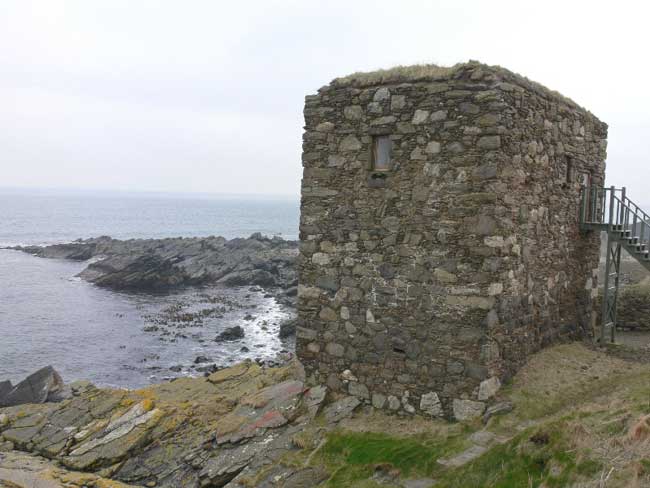Location
50 yards seaward from Kinnaird Head lighthouse/castle built over a 30m (100 feet) long cave known as the Selches Hole.
Fraserburgh, Aberdeenshire
OS Map Reference
NJ 999 675
Description
The oldest building in Fraserburgh, probably named from a past use as a wine cellar or possibly a corruption of "wynd tower".
Its original purpose is still the subject of some academic debate. It is roughly built of rubble with three vaulted storeys, the centre reached by a hatch from the uppermost. This first floor level is lit only by one small window in the E wall. The original entrance is at second floor level and had been reached by a ladder or moveable stair, arriving at a landing supported by two stone corbels which are still extant. The outer doorway admits to a small vestibule which is closed by an inner door beneath which is the hatch to the two lower levels. The upper chamber has a window in each of its four walls and has a remarkable series of finely carved heraldic pendant bosses, three in the main vault and one in each of the four arched window soffits. Bryce suggests that this upper chamber was designed to serve as a Roman Catholic chapel. The fact that this chamber was raised, concealed, semi-defended and provided with two -secret- chambers below, points to the true date of this enigmatic structure as belonging to the period of the Reformation in Scotland. from SMR
Related Information
Alexander Fraser(8th of Philorth) made additions to the castle of Philorth, now Cairnbulg (NK 016 639), in order to create a more fashionable house than his grandfather's Kinnaird Castle (NJ 998 675) on an exposed headland well suited for its present function as a lighthouse. Another of Fraser's buildings, the curiously named Wine Tower (NJ 999675), stands on the same headland (Bryce 1989). Externally plain, its sole entry is raised high above ground level and was originally reached by ladder. As the lowest chamber is pierced only by a useless diagonal gun-port and the middle chamber above it by a window to the sea, it becomes evident that the entire structure was designed to prevent the viewing of its interior. The uppermost room appears to be a chapel. Set in the arch of the ingoes of each of its four windows is a pendant stone boss, one carved with the arms of Alexander Fraser and his first wife, two others with those of his predecessors, and the fourth with the arms of the earls of Mar and Huntly (Calvinist and Catholic respectively). Three further bosses in the crown of the vault bear the arms of Fraser of Philorth, James VI and, at the north end, the Arma Christi . As none of the arms is later than those of Alexander Fraser and Magdalene Ogilvie (whose marriage took place in 1570) it is clear that the tower must be the work of the 8th Laird. This is further confirmed by the window sills, which are fashioned to provide triple-splayed shot-holes, an architectural conceit unknown in the north before the 1570s.
Sir Alexander Fraser is said to have had his daughter's lover, of whom he disapproved, chained to a sea cave below the Wine Tower, where the poor man drowned (during a nocturnal storm). His daughter, Isobel, threw herself to her death on finding that her lover had been killed. An apparition is said to been seen by the Wine Tower whenever there is a storm.
Era
1500s
Information Source
Abdns. Sites and Monuments Record, Post-Reformation Catholic houses of north-east
Scotland , Ian B D Bryce & Alasdair Roberts
Categories
Iconography
- heraldic motifs
External Links
Photographer
- Michael Watt
Unavailable Data
- Date
- Related Artefacts
- Creator
This content was submitted by external contributors and does not necessarily reflect the views of the University of Aberdeen.



